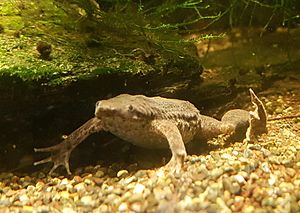Sabana Surinam toad facts for kids
Quick facts for kids Sabana Surinam toad |
|
|---|---|
 |
|
| Conservation status | |
| Scientific classification | |
| Genus: |
Pipa
|
| Species: |
parva
|
| Synonyms | |
|
Protopipa parva (Ruthven and Gaige, 1923) |
|
The Pipa parva, also known as the Sabana Surinam toad or dwarf toad, is a type of frog. It belongs to the Pipidae family of frogs. Scientists Alexander Grant Ruthven and Helen Beulah Thompson Gaige first described this species in 1923.
You can find the Sabana Surinam toad in parts of northwestern Venezuela and northeastern Colombia. It mostly lives around the Maracaibo Basin. There is also a group of these toads in the Lake Valencia area in northern Venezuela. This group was brought there by people and is now growing.
Contents
What Does the Sabana Surinam Toad Look Like?
These small toads have a unique appearance. Adult male toads are about 28 to 37 millimeters long. Female toads are a bit bigger, measuring about 27 to 44 millimeters long. This measurement is from their snout (nose) to their vent (tail end).
The toad's head is narrow when you look at it from above. Its snout is pointed, and it has large eyes. The body of the Sabana Surinam toad is quite slender. Its skin feels bumpy, which is called tuberculate. The skin between its fingers and toes is clear, like a thin web.
Where Do Sabana Surinam Toads Live?
The Pipa parva lives in flat, open areas. Its natural habitats include lakes, ponds, and marshes. You can often find them in grasslands or places that get flooded. These toads can even travel across land to find new water sources.
In Venezuela, they live from sea level up to about 300 meters (about 984 feet) above sea level. In Colombia, they are found between 50 and 135 meters (about 164 to 443 feet) above sea level.
Life Cycle and Reproduction
The female Sabana Surinam toad has a special way of carrying her eggs. She carries them on her back! When the eggs hatch, tiny tadpoles come out from her back. These tadpoles then swim into the water, where they continue to grow and develop into adult frogs.
How Are Sabana Surinam Toads Doing?
The Pipa parva is a very common species. In fact, there are so many of them that some people even see them as a pest. This means their numbers are strong and they are not in danger. The good news is that there are no major threats to this species. Even efforts to control them as pests do not seem to harm their overall population.
However, there is a concern about this toad spreading into the Orinoco Basin. If they spread too much, they could affect the balance of other species in that area.
See also
 In Spanish: Sapo pipa enano para niños
In Spanish: Sapo pipa enano para niños


